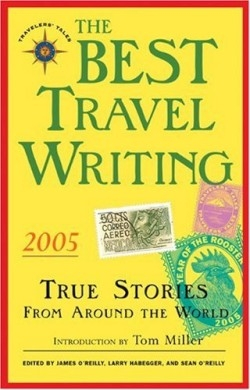The Best Travel Writing 2005
- 2005 INDIES Finalist
- Finalist, Travel Essays (Adult Nonfiction)
For arguments sake, one could divide the world into non-travelers and travelers. Non-travelers are those for whom long lines at Homeland Security checkpoints are obstacle enough to keep them from venturing beyond safe and familiar environs. Travelers are recognizable by their ubiquitous, threadbare backpacks-people for whom confrontations with Uzi-toting tribal warlords along vine-shrouded yak paths seem like just another day in the jungle.
Having collectively visited more than ninety countries and written about their adventures for some twenty-five years, the editors (OReilly is president of Travelers Tales) are well able to pick fellow travelers out of a crowd. The twenty-seven authors featured in this book are travelers all.
From Bali to the Balkans, Cambodia to California, Spain to Saudi Arabia, the locations range from the sensational to the sublime, united by the authors talents for imaginatively bringing to life that sense of place that lies at the genres core. As Paul Harper learns from Nigerian storytellers, such “vibrant narratives weave together the thread of peoples lives,” revealing the common bonds that connect individuals and societies regardless of polar extremes of sophistication or wealth, politics or religion-“the limitless kindness and bottomless cruelty of humanity” that Mark Jenkins encounters during his Graham Greene-like trek along “The Ghost Road.”
What induces a traveler to travel? A general restlessness, an adventurers wanderlust, perhaps, or maybe even a specific, Quixotic goal, the destination selected as if to appease some nagging, subconscious imperative. They travel either to find themselves or lose themselves-to have their identities unmasked, or their egos obscured-by immersion in another culture.
Such an epiphany can come anytime, anywhere, which is one of the enduring lessons imparted by this anthology. Mark Hawthorne writes that the revelation came to him in the Himalayan village of Ladakh: “I was overcome by a sense of belonging-something I had never felt in any other country … I gained an inner perspective that was both exhilarating and startling.” Bill Sherwonits self-awareness blossomed one frigid, cloudless night in Alaskas Denali State Park. Burrowing deep into his sleeping bag, he gazed toward the heavens and in the dense blanket of stars discovered “a taste of infinity, an escape from ego.”
Nor are journeys measured exclusively by interminable miles and government-issued stamps on dog-eared passports. Though Patrick Fitzhugh was physically navigating Italys Amalfi coast as he retraced Odysseuss steps, he was really reaching back in time to his fathers bedtime stories, nightly readings designed to excite Patrick about the legendary travelers valor and determination. The child he was then didnt buy it; the man he became discovered too late who the true hero was.
Fitzhughs is only one example of what the anthology so cogently demonstrates. Whereas in literary circles, travel writing is frequently given second-class citizenship-lampooned by Robert L. Strauss in “Confessions of a Travel Writer” as a career path akin to “the literary road to ruin” traversed by “the lower species of the modern literary world”-such pejorative dismissals are too facile to be valid. Travel writing can be brutally honest, deceptively simple, vividly poetic. It can be embarrassingly personal or universally recognizable, profoundly compassionate or shockingly repulsive.
The best travel writing entertains and enlightens, inspires and instructs. Kathryn Kefauver manages to do all these things at once, in her unaffected yet forceful imagery from “Part Lao, Part Falang”: “The symptoms for river blindness formed a perfect haiku: skin can become thick, / dark, scaly redness and tears, / finally, blindness.” There, in the poetic forms classic seventeen syllables, she conveys both the substance of the country and her experience within it, capturing the reality of life in a developing culture and communicating its effect upon her with crisp clarity and lyric vitality.
As Pico Iyer, that don of travel writers, explains in “Prayer Flags and Refugees,” his incisive profile of the Tibetan government in exile: “The point of travel for me is to … confront the questions that I never have to think about at home, and am not sure can ever be easily answered.”
The point of reading about travel poses just as complex a question. One may read it to live vicariously, knowing full well that it is simply not within oneself to eat duck embryos in Laos. Or one may read travel writing as a scholarly, anthropological glimpse into other cultures. But one will have a richer experience if one reads travel writing as these authors and editors have intended: as a way of learning about oneself, of embracing the boundless possibilities for a shared humanity, whether in Tahiti or Timbuktu, India or Indianapolis.
Reviewed by
Carol Haggas
Disclosure: This article is not an endorsement, but a review. The publisher of this book provided free copies of the book to have their book reviewed by a professional reviewer. No fee was paid by the publisher for this review. Foreword Reviews only recommends books that we love. Foreword Magazine, Inc. is disclosing this in accordance with the Federal Trade Commission’s 16 CFR, Part 255.

